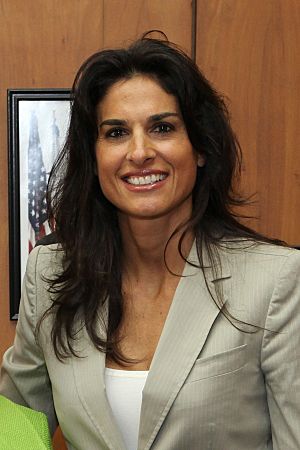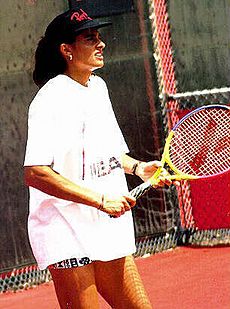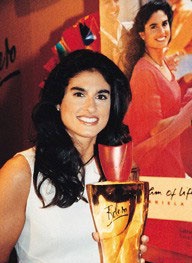Gabriela Sabatini facts for kids

Sabatini at the US Embassy
in Buenos Aires, January 2012 |
||||||||||||||
| Full name | Gabriela Beatriz Sabatini | |||||||||||||
|---|---|---|---|---|---|---|---|---|---|---|---|---|---|---|
| Country (sports) | ||||||||||||||
| Residence | Buenos Aires, Argentina Boca Raton, Florida, U.S. |
|||||||||||||
| Born | 16 May 1970 Buenos Aires |
|||||||||||||
| Height | 1.75 m (5 ft 9 in) | |||||||||||||
| Turned pro | 1982 | |||||||||||||
| Retired | 1996 | |||||||||||||
| Plays | Right-handed (one-handed backhand) | |||||||||||||
| Prize money | $8,785,850 | |||||||||||||
| Int. Tennis HoF | 2006 (member page) | |||||||||||||
| Singles | ||||||||||||||
| Career record | 632–189 (76.98%) | |||||||||||||
| Career titles | 27 | |||||||||||||
| Highest ranking | No. 3 (27 February 1989) | |||||||||||||
| Grand Slam singles results | ||||||||||||||
| Australian Open | SF (1989, 1992, 1993, 1994) | |||||||||||||
| French Open | SF (1985, 1987, 1988, 1991, 1992) | |||||||||||||
| Wimbledon | F (1991) | |||||||||||||
| US Open | W (1990) | |||||||||||||
| Other tournaments | ||||||||||||||
| Tour Finals | W (1988, 1994) | |||||||||||||
| Olympic Games | F (1988) | |||||||||||||
| Doubles | ||||||||||||||
| Career record | 252–96 | |||||||||||||
| Career titles | 14 | |||||||||||||
| Highest ranking | No. 3 (6 November 1988) | |||||||||||||
| Grand Slam doubles results | ||||||||||||||
| Australian Open | SF (1989) | |||||||||||||
| French Open | F (1986, 1987, 1989) | |||||||||||||
| Wimbledon | W (1988) | |||||||||||||
| US Open | SF (1986, 1987, 1988, 1989, 1994, 1996) | |||||||||||||
|
Medal record
|
||||||||||||||
Gabriela Beatriz Sabatini (born May 16, 1970) is a famous former professional tennis player from Argentina. She was one of the best players from the mid-1980s to the mid-1990s. Gabriela reached world No. 3 in both singles and doubles. She won 41 titles in her career, combining singles and doubles events.
In singles, Gabriela won the US Open in 1990. She also won the WTA Finals twice, in 1988 and 1994. She finished second at Wimbledon in 1991 and the US Open in 1988. At the 1988 Summer Olympics, she won a silver medal. In doubles, she won Wimbledon in 1988 with her partner Steffi Graf. She also reached three French Open finals in doubles.
Gabriela Sabatini holds a special record: among players who didn't reach the world No. 1 ranking, she beat the reigning No. 1 player more times than anyone else. In 2006, she was honored by joining the International Tennis Hall of Fame. In 2018, Tennis Magazine named her the 20th greatest female player of the last 50 years.
Contents
Early Life and Junior Tennis Career
Gabriela Sabatini was born on May 16, 1970, in Buenos Aires, Argentina. Her parents were Osvaldo and Beatriz Sabatini. Her father worked as an executive for General Motors. Gabriela also has an older brother named Osvaldo, who became an actor and producer.
Gabriela started playing tennis when she was just six years old. She won her very first tournament at the age of eight. In 1983, when she was 13, she made history by becoming the youngest player ever to win the Orange Bowl tournament in Miami, Florida. The next year, in 1984, she won the girls' singles title at the French Open. She also won the US Open girls' doubles with her fellow Argentinian player, Mercedes Paz. That same year, Gabriela became the world's No. 1 junior player. The International Tennis Federation named her the 1984 Junior World Champion.
Gabriela later shared something interesting about her junior career. She said she sometimes lost matches on purpose when she was young. She did this to avoid having to do interviews on the court. She was very shy and thought she had to speak to the media if she reached a tournament final. So, she would sometimes lose in the semifinals instead.
Professional Tennis Career
Starting Out in Professional Tennis
In 1985, Gabriela Sabatini was only 15 years and three weeks old. She became one of the youngest players ever to reach the semifinals of the French Open. There, she played against the legendary Chris Evert and lost. Later that year, she won her first WTA Tour singles title in Tokyo. By September 1985, she entered the world's top ten players, reaching No. 10. She finished that year ranked No. 12. Because of her great start, she received the WTA Newcomer of the Year award.
In 1986, Gabriela reached the semifinals of Wimbledon, where she lost to Martina Navratilova. After that, she won her second WTA title in Buenos Aires. She re-entered the world's top ten in September 1986. She stayed in the top ten for an amazing 508 weeks in a row, until May 1996.
Gabriela reached the semifinals of the 1987 French Open. She also made it to the final of the 1987 WTA Tour Championships. In both matches, she lost to Steffi Graf. However, she won three WTA titles that year. One of her wins was against world No. 4, Pam Shriver, in Brighton.
1988: Big Finals and a Wimbledon Win
In February 1988, Gabriela Sabatini moved into the top five in the world rankings. She stayed in the top five without interruption until August 1993. After reaching her third French Open semifinal, she made it to her first Grand Slam singles final at the US Open. She played against Steffi Graf and lost in three sets.
Gabriela proudly represented Argentina at the 1988 Summer Olympics in Seoul. She was chosen to carry her country's flag during the opening ceremony. She went on to win the silver medal in the women's singles competition, again losing to Graf in the final. That same year, Gabriela teamed up with Steffi Graf to win the women's doubles title at Wimbledon. At the end of 1988, Gabriela won her first WTA Tour Championships. She won this important tournament without losing a single set.
1989: More Titles and Top Wins
In 1989, Gabriela Sabatini reached seven tournament finals and won four titles. This included winning the Miami Open, where she beat Chris Evert in the final. She also won the Amelia Island title by defeating world No. 2, Martina Navratilova, and world No. 1, Steffi Graf. This made her only the fifth player in the Open Era to beat both the No. 1 and No. 2 ranked players in the same tournament. She also reached the semifinals of the Australian Open and US Open Grand Slam tournaments.
1990: US Open Champion!
At the Australian Open in 1990, Gabriela sprained her ankle during a match. She had to leave the court in a wheelchair. Other players had complained that the court surface was too sticky and dangerous in hot weather. Gabriela was out of action for six weeks because of the injury. She returned to the tour in mid-March and won her first tournament back, the Virginia Slims of Florida, without losing a set.
She reached the semifinals of Wimbledon, where she lost to Martina Navratilova.
At the US Open, Gabriela reached her second Grand Slam final. She defeated world No. 1 Graf in straight sets, 6–2, 7–6. She saved two set points when she was down 5-6 in the second set. Gabriela said her win came from being more aggressive and moving to the net to attack Graf's shorter shots. She also beat Graf in the semifinals of the WTA Championships later that year. However, she lost in the final to Monica Seles in a very long match. It was the first five-set match played on the women's tour since 1901.
1991: Close to World No. 1
Gabriela won five tournaments in the first half of 1991. She beat three top five players (Graf, Navratilova, and Fernandez) to win the title in Tokyo. She also beat Graf three more times in Boca Raton, Key Biscayne, and Amelia Island. In the Italian Open final, Gabriela defeated world No. 1 Seles, losing only five games.
She reached the semifinals at the French Open. She then made it to her third Grand Slam singles final at Wimbledon. She lost to Graf 4–6, 6–3, 6–8, even though she had served for the match twice. Gabriela was very close to becoming the world No. 1 in 1991. But Steffi Graf and Monica Seles just barely kept ahead of her. Her great year ended with her receiving the WTA Most Improved Player of the Year award.
1992: Another Strong Year
In 1992, Gabriela Sabatini reached eight finals and won five titles. This included her fourth Italian Open title, where she again beat world No. 1 Seles in the final. She also won in Amelia Island (defeating Graf) and Hilton Head. She reached the semifinal stage at three of the four Grand Slams: the Australian Open, French Open, and Wimbledon. She also made it to the quarterfinals at the US Open.
1993: Tough Matches
At the Australian Open, Gabriela reached the semifinals. She saved three match points in the quarterfinals against Mary Pierce before winning. She then lost to the eventual champion, Monica Seles. She reached two finals in a row at the Italian Open and German Open. At the French Open in June, Gabriela lost to Mary Jo Fernandez in the quarterfinals. The match went to 8–10 in the final set. At the time, it was the third longest match in Open Era tennis. Gabriela had even been leading 5–1 in the second set. She also reached the quarterfinals at Wimbledon and the US Open, where she lost to Graf.
That year, in May, Monica Seles was attacked during a tournament. The tour organizers held a vote among the top players. They wanted to decide if Seles should keep her world No. 1 ranking while she recovered. Out of 17 players who voted, all but Gabriela voted against protecting Seles' ranking. Gabriela chose not to vote. Even though the vote was against it, Seles was later given a shared No. 1 ranking with Graf when she returned to tennis two years later.
1994: Second WTA Finals Win
In 1994, Gabriela Sabatini reached the finals of Amelia Island and Strasbourg. She also made it to the semifinals of both the Australian Open and US Open. From Wimbledon 1990 to the Australian Open 1994, she reached at least the quarterfinals in 15 Grand Slam events in a row. This was the third longest streak of consecutive Grand Slam quarterfinal appearances in women's tennis history. In November, Gabriela defeated Lindsay Davenport in the final of the WTA Championships in New York. This was her second title at that tournament. In the first round, she beat world No. 6, Martina Navratilova. This was Navratilova's last match before she retired.
1995: More Great Matches
In 1995, Gabriela won the title at the Sydney International, beating Davenport in the final. She also reached a record seventh final at the Amelia Island Championships and her third final at the Porsche Tennis Grand Prix. She made it to the quarterfinals of both the French Open and Wimbledon. She also reached the semifinals of the US Open, where she lost to the eventual champion, Graf. This semifinal was the 40th and final match between Gabriela and Graf. Graf led their matches 29–11. Gabriela's 11 wins against Graf meant she had beaten Graf more times than any other player ever managed.
1996: Injury and Retirement
Gabriela Sabatini missed several months of the 1996 season because of a stomach muscle injury. In October, in New York, she announced that she was retiring from professional tennis. At the end of the year, she received the WTA Diamond Aces Award. This award is given to the player who has done the most to promote tennis both on and off the court.
From 1986 until her injury in 1996, Gabriela spent 508 weeks in a row in the world's top 10. This is the fourth longest top-10 streak in WTA tour history. She spent 312 of those weeks in the world's top five. She also finished six seasons in a row with a top-5 ranking. Gabriela reached the semifinal stage or better in Grand Slam championships 18 times in singles and 14 times in doubles. She reached at least one Grand Slam singles semifinal for 11 consecutive years. During her career, she defeated the reigning world No. 1 player ten times.
In 2000, Gabriela Sabatini received the Diamond Konex Award. This award recognized her as the most outstanding "Sportsperson of the Decade" in Argentina. In July 2006, she was officially welcomed into the International Tennis Hall of Fame.
Life Outside of Tennis
In the late 1980s, Gabriela Sabatini started her own line of perfumes. She partnered with a German perfume company called Mülhens. Her first special scent came out in 1989. Even after she retired from tennis, she continued to promote her perfume lines.
In 1992, Gabriela became the first tennis player ever to have a rose named after her. It was an orange-red flower.
The Great American Doll Company created a doll that looked like Gabriela in 1994. The doll was dressed in tennis clothes. That same year, Gabriela published a book called My Story. It was a motivational book.
In 2003, she became an Italian citizen. This was because her great-grandfather, David Sabatini, was born in Italy. He moved to Argentina in the late 1800s.
A statue of Gabriela Sabatini was revealed in central Buenos Aires in 2014. It was placed next to statues of other famous Argentinian sports stars. These include Lionel Messi, Diego Maradona, Guillermo Vilas, and Roberto de Vicenzo. However, within weeks of its unveiling, the bronze tennis racket was stolen from the statue's hand.
In 2017, Gabriela was given the International Club's special Jean Borotra Sportsmanship Award. This award recognized her fair play during her career and her charity work after retiring. She received the award from Rod Laver at the 2018 Wimbledon Championships.
In 2019, the ITF gave Gabriela its highest honor, the Philippe Chatrier Award. This was for her achievements in tennis and her charity work after retirement. She worked with organizations like UNICEF, UNESCO, and the Special Olympics. She also served as an 'Athlete Role Model' at the 2018 Youth Olympic Games.
Gabriela Sabatini lives in Buenos Aires, Argentina. She also has homes in Boca Raton, Florida, and Pfäffikon, Switzerland.
Grand Slam Tournament Results
| W | F | SF | QF | #R | RR | Q# | A | NH |
Singles Results
| Tournament | 1984 | 1985 | 1986 | 1987 | 1988 | 1989 | 1990 | 1991 | 1992 | 1993 | 1994 | 1995 | 1996 | SR | W–L |
|---|---|---|---|---|---|---|---|---|---|---|---|---|---|---|---|
| Australian Open | A | A | NH | A | A | SF | 3R | QF | SF | SF | SF | 1R | 4R | 0 / 8 | 29–8 |
| French Open | A | SF | 4R | SF | SF | 4R | 4R | SF | SF | QF | 1R | QF | A | 0 / 11 | 42–11 |
| Wimbledon | A | 3R | SF | QF | 4R | 2R | SF | F | SF | QF | 4R | QF | A | 0 / 11 | 42–11 |
| US Open | 3R | 1R | 4R | QF | F | SF | W | QF | QF | QF | SF | SF | 3R | 1 / 13 | 51–12 |
| Win–loss | 2–1 | 7–3 | 11–3 | 13–3 | 14–3 | 14–4 | 17–3 | 19–4 | 19–4 | 17–4 | 13–4 | 13–4 | 5–2 | 1 / 43 | 164–42 |
| Year-end ranking | 74 | 12 | 9 | 6 | 4 | 3 | 5 | 3 | 3 | 5 | 7 | 7 | 56 |
Doubles Results
| Tournament | 1984 | 1985 | 1986 | 1987 | 1988 | 1989 | 1990 | 1991 | 1992 | 1993 | 1994 | 1995 | 1996 | Career SR |
|---|---|---|---|---|---|---|---|---|---|---|---|---|---|---|
| Australian Open | A | A | NH | A | A | SF | 2R | 3R | A | A | A | 2R | QF | 0 / 5 |
| French Open | A | 1R | F | F | SF | F | A | SF | A | A | 3R | 3R | A | 0 / 8 |
| Wimbledon | A | 2R | A | 3R | W | QF | QF | A | A | A | 1R | SF | A | 1 / 7 |
| US Open | A | 1R | SF | SF | SF | SF | 3R | A | A | A | SF | 2R | SF | 0 / 9 |
| Grand Slam SR | 0 / 0 | 0 / 3 | 0 / 2 | 0 / 3 | 1 / 3 | 0 / 4 | 0 / 3 | 0 / 2 | 0 / 0 | 0 / 0 | 0 / 3 | 0 / 4 | 0 / 2 | 1 / 29 |
| Year-end ranking | 128 | 54 | 9 | 5 | 3 | 19 | 29 | 55 | NR | NR | 14 | 13 | NR |
See also
 In Spanish: Gabriela Sabatini para niños
In Spanish: Gabriela Sabatini para niños
- Performance timelines for all female tennis players who reached at least one Grand Slam final
- Open Era tennis records – women's singles
- Graf–Sabatini rivalry
- Tweener (tennis)
- List of rose cultivars named after people



